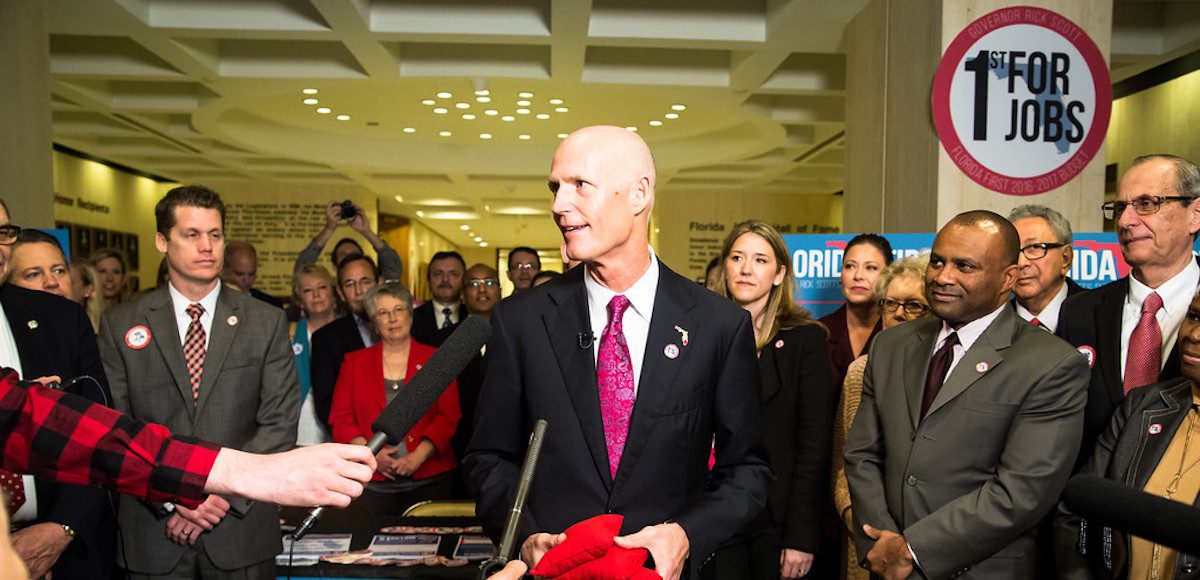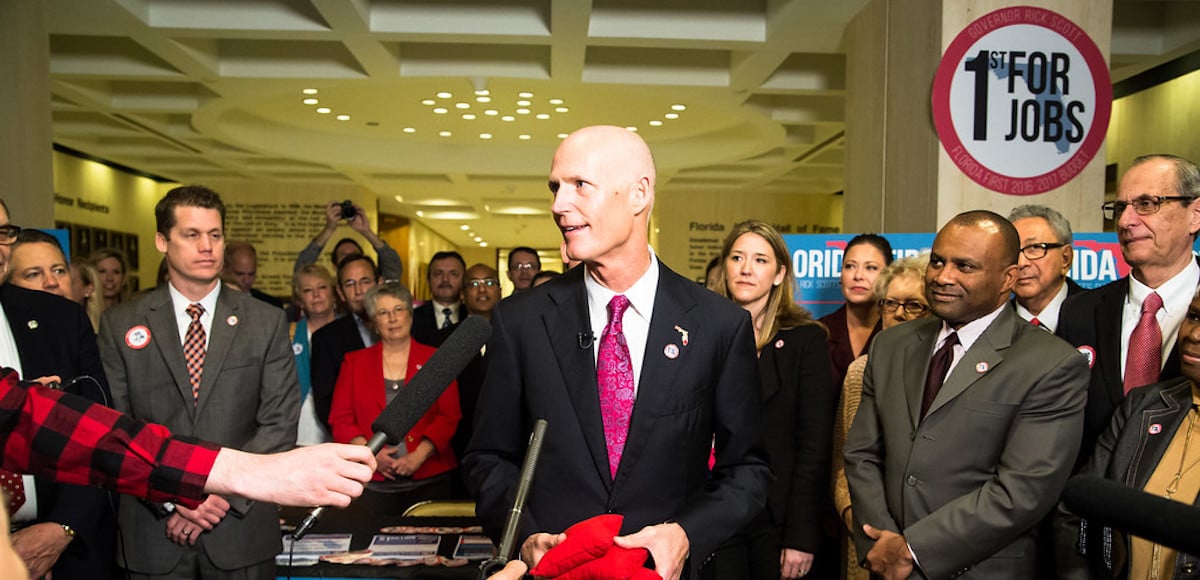

TALLAHASSEE, Fla. – Florida Gov. Rick Scott attends the “First for Jobs” rally with roughly 600 people on March 14, 2017. (Photo: Carolyn Allen)
A new study finds Red States have a higher taxpayer return on investment (ROI) than Blue States, with an average ranking of 20.60 juxtaposed to 32.85.
WalletHub took a look at state and local tax collections for each of the 50 states and contrasted them with 25 key metrics to gauge the quality of the services residents receive. They were broken down by 5 categories: Education, Health, Safety, Economy, and Infrastructure & Pollution.
Each category was worth 20 points.
Worth noting, States were classified as Red or Blue based on how they voted in the 2016 presidential election. That’s significant considering several states have policies that would not be considered Red or Blue. For instance, New Hampshire, which ranked first for ROI, is not a tax-and-spend state.
Whether it’s currently led by a Democrat or voted for a Democrat on the national level, policy-wise The Granite State is a conservative state.
| Rank (1=Best) | State | Rank (50=Worst) | State |
|---|---|---|---|
| 1 | New Hampshire | 41 | Maryland |
| 2 | Florida | 42 | Delaware |
| 3 | South Dakota | 43 | Nevada |
| 4 | Colorado | 44 | New Mexico |
| 5 | Virginia | 45 | Vermont |
| 6 | Alaska | 46 | New York |
| 7 | Missouri | 47 | North Dakota |
| 8 | Texas | 48 | California |
| 9 | Utah | 49 | Arkansas |
| 10 | Iowa | 50 | Hawaii |
Hawaii, which is arguably the Bluest of Blue States, has the worst taxpayer return on investment (ROI), with Arkansas (Red) and California (Blue) not far behind at 49 and 48, respectively.
Federal Taxes Paid vs. Spending Received by State
| ‘Taxpayer ROI’ Rank (1=Best) |
State | ‘Total Taxes Paid per Capita’ Rank* | ‘Overall Government Services’ Rank |
|---|---|---|---|
| 1 | New Hampshire | 3 | 2 |
| 2 | Florida | 2 | 31 |
| 3 | South Dakota | 10 | 14 |
| 4 | Colorado | 14 | 13 |
| 5 | Virginia | 17 | 9 |
| 6 | Alaska | 1 | 49 |
| 7 | Missouri | 5 | 35 |
| 8 | Texas | 6 | 36 |
| 9 | Utah | 21 | 10 |
| 10 | Iowa | 36 | 3 |
| 11 | Nebraska | 28 | 11 |
| 12 | Georgia | 11 | 39 |
| 13 | South Carolina | 4 | 42 |
| 14 | Arizona | 12 | 37 |
| 15 | Wisconsin | 35 | 6 |
| 16 | Tennessee | 8 | 41 |
| 17 | Idaho | 23 | 20 |
| 18 | Oklahoma | 13 | 40 |
| 19 | Ohio | 15 | 32 |
| 20 | Indiana | 25 | 22 |
| 21 | Kansas | 30 | 16 |
| 22 | Montana | 16 | 33 |
| 23 | North Carolina | 19 | 30 |
| 24 | Alabama | 9 | 47 |
| 25 | Maine | 32 | 18 |
| 26 | Illinois | 34 | 15 |
| 27 | Rhode Island | 33 | 19 |
| 28 | Michigan | 27 | 29 |
| 29 | Pennsylvania | 31 | 25 |
| 30 | Oregon | 26 | 34 |
| 31 | Kentucky | 22 | 38 |
| 32 | Wyoming | 39 | 17 |
| 33 | Washington | 37 | 24 |
| 34 | Louisiana | 7 | 50 |
| 35 | New Jersey | 41 | 12 |
| 36 | Massachusetts | 43 | 7 |
| 37 | Minnesota | 47 | 1 |
| 38 | Mississippi | 18 | 45 |
| 39 | Connecticut | 46 | 8 |
| 40 | West Virginia | 24 | 44 |
| 41 | Maryland | 40 | 27 |
| 42 | Delaware | 42 | 23 |
| 43 | Nevada | 29 | 43 |
| 44 | New Mexico | 20 | 48 |
| 45 | Vermont | 48 | 4 |
| 46 | New York | 44 | 21 |
| 47 | North Dakota | 50 | 5 |
| 48 | California | 45 | 28 |
| 49 | Arkansas | 38 | 46 |
| 50 | Hawaii | 49 | 26 |
*“Per Capita” includes the population aged 18 and older.
Methodology
In order to determine which states yield the best and worst return on investment (ROI) for taxpayers, WalletHub compared the quality of government services received by residents to the total state and local taxes they pay in each of the 50 states.
First, we analyzed each state across five key government-service categories: 1) Education, 2) Health, 3) Safety, 4) Economy and 5) Infrastructure & Pollution. The categories were further broken down into 25 relevant metrics, which are listed below with their corresponding weights. Each metric was graded on a 100-point scale, with a score of 100 representing the best quality of government service.
We then determined each state’s weighted average across all 25 metrics to calculate its “Overall Government Services Score.”
Finally, we constructed the Taxpayer ROI ranking by comparing each state’s “Overall Government Services Score” to its “Total Taxes Paid per Capita.” “Per Capita” includes the population aged 18 and older.








WickedTwei / April 3, 2018
I honestly wanna know how red states have better ROI when they’re also more dependent on fed govt money.
/